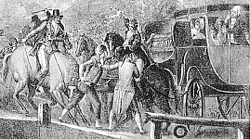![]()
In 1791, the National Assembly finally
gave France its first constitution. The new constitution established a
limite monarchy with separation of powers between the executive, legislative,
and judicial branches. At the head of the
executive branch was the hereditary king. He could propose
no laws, and could only use a temporary veto to block legislation he did
not like. The Legislative Assembly passed the nation's laws. Members of
the Assembly had to be property owners elected by taxpaying citizens. A
new system of courts was set up as the judicial branch.
![]()
Louis' Flight to Varennes

Louis XVI resented the loss of his
absolute power. On June 21, he
attempted to flee from Paris with
Marie Antoinette and his family. He
left behind him a defiant message
in which he denounced the
revolution. He planned to join with
noblemen and seek help
from foreign powers. Almost at his
destination, the king was
recognized and stopped. The king and
his family were compelled to
return to the capital where he was
forced to accept his status as a
constitutional monarch.
![]()
End of the Monarchy
The new Legislative Assembly held its
first session in October 1791. The seating arrangements in the Assembly
reflected divisions among the revolutionaries. Moderate revolutionaries
sat on the right side of the meeting hall, and radical revolutionaries
sat on the left side. The moderates, in general, supported the limited
monarchy and wanted to preserve the Constitution of 1791. This proved impossible,
however, since too many groups were dissatisfied with the Revolution and
opposed limited monarchy. The Girondins, a political party representing
the bourgeoisie, favored a middle-class republic similar to that of the
United States. The Jacobins, a radial political party, represented the
city workers, who paid no taxes and, therefore, under the constitution
of 1791, had no voice in the government. They
opposed both the king and the bourgeoisie. The Jacobins
desired a republic dominated by the poorer people.
![]()
France at War
Some European leaders began to fear
that revolution would spread to their countries. In the Declaration of
Pillnitz (August 1792), Prussia and Austria threatened to use force to
protect the French royal family and safeguard the
monarchy. Insulted by this threat, the Legislative Assembly
declared war on Austria. Prussia joined immediately with Austria, and by
the summer of 1792 the two powers invaded France. The French fared badly
in the initial fighting.
In Paris, defeat in war and economic
shortages led to political demonstrations, especially against the king.
On August 10, a Paris mob attacked the Tuileries Palace and Legislative
Assembly. They took the king captive and forced the Legislative Assembly
to suspend the monarchy and call for a National Convention that would draft
a constitution for a French republic. The National Convention was chosen
on the basis of universal manhood suffrage. (Under a system of universal
manhood suffrage, all adult males had the right to vote.) The French Revolution
was about to enter a more radical stage.